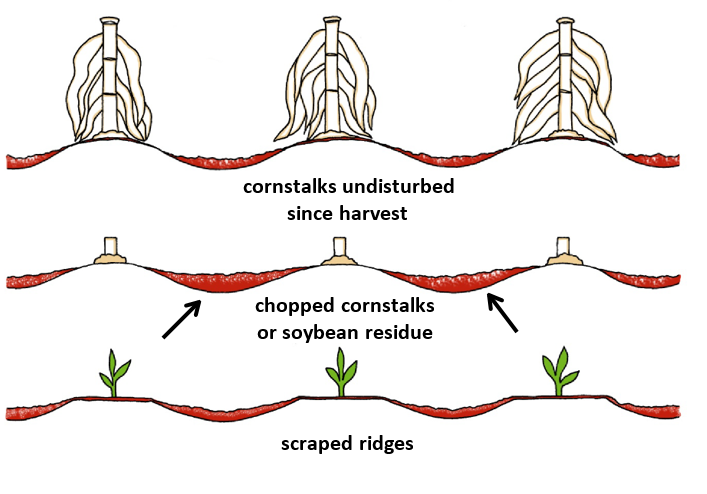Application: Large and small-scale farmers and farmer groups
Description: Tillage is the agricultural preparation of the soil by mechanical, draught animal or human-powered agitation, such as ploughing, digging, overturning, shovelling, hoeing and raking. Small-scale farming tends to use smaller-scale methods, employing hand-tools and in some cases draught animals, whereas medium, to large-scale farming tends to use larger-scale instruments such as tractors. The overall goal of tillage is to increase crop production while conserving resources (soil and water) and protecting the environment. Conservation tillage refers to a number of strategies and techniques for establishing crops in a previous crop’s residues, which are purposely left on the soil surface. Conservation tillage practices typically leave about one-third of crop residue on the soil surface. This slows water movement, which reduces the amount of soil erosion. Conservation tillage is suitable for a range of crops including grains, vegetables, root crops, sugar cane, cassava, fruit and vines. There is great potential to bring this technology to Cambodia, although limiting factors have to be taken into account (see limitations below).
The most common conservation tillage practices are no-till, ridge-till and mulch-till.
No-till is a way of growing crops without disturbing the soil. This practice involves leaving the residue from last year’s crop undisturbed and planting directly into the residue on the seedbed. No-till requires specialised seeding equipment designed to plant seeds into undisturbed crop residues and soil. No-till farming changes weed composition drastically. Faster growing weeds may no longer be a problem in the face of increased competition, but shrubs and trees may begin to grow eventually. Cover crops, or green manure, can be used in a no-till system to help control weeds. Cover crops are usually leguminous which are typically high in nitrogen can often increase soil fertility.
Ridge-till is a practice where the soil is left undisturbed from harvest to planting and crops are planted on raised ridges. Planting usually involves the removal of the top of the ridge. Planting is completed with sweeps, disk openers, coulters, or row cleaners. Residue is left on the surface between ridges. Weed control is accomplished with cover crops, herbicides and/or cultivation. Ridges are rebuilt during row cultivation.
Mulch-till techniques involve disturbing the soil between harvesting one crop and planting the next but leaving around a third of the soil covered with residues after seeding. Implements used for mulch-till techniques include chisels, sweeps, and field cultivators.
Contribution to climate resilience: The key benefits from this adaptation option are as follows: (a) high scalability, (b) high relevance at community/farmer level, and (c) low negative impact on environment, and health and safety. It is considered to have a high impact on climate change adaptation because of the perceived benefits from improved land and soil management as a result of improved management of water and organic matter. The negative aspects of this technology are the high cost and high labour demand, resulting on affordability and equity issues. Overall the option is considered to have a medium relative score within the MCA.
Supplementary sources of information:
Background image credit: https://pixabay.com/photos/plough-plow-agriculture-arable-3455422/
This resilience-building measure is sourced from the Adaptation Technologies Guide – Agriculture, Phnom Penh, Cambodia (2019) published by the Ministry of Agriculture, Forestry and Fisheries and the National Council for Sustainable Development at the Ministry of Environment in Cambodia. The full Guide is available to download at URL https://ncsd.moe.gov.kh/sites/default/files/2019-10/Adaptation%20Technologies%20Guide-Agriculture_June%202019_En.pdf


